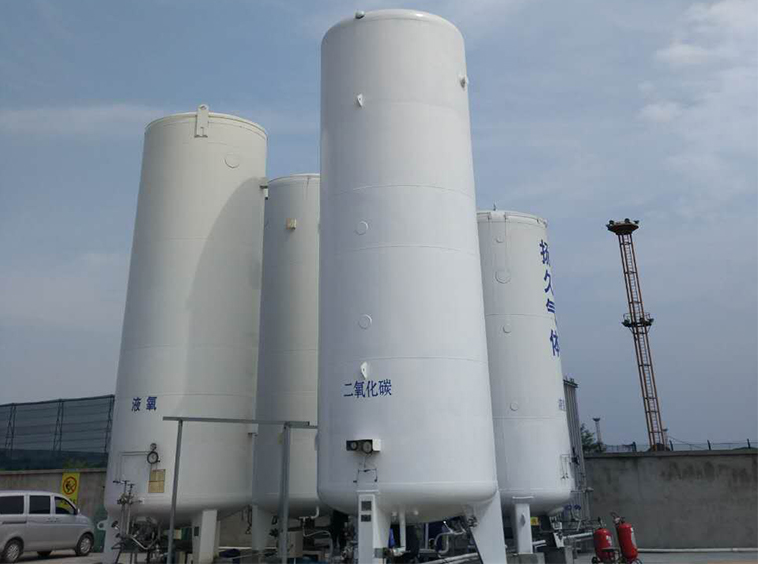Name: Jiangsu Jianye Chemical Equipment Co., Ltd.
Contact: Liu Yong
Phone:0512-58370568
Mobile:13806225925
Fax:0512-58371568
Mailbox:ly925@jylng.cn
Address: Sanjiali Road, Nansha, Jingang Town, Zhangjiagang City
Website:en.jylng.cn
Low-temperature storage tanks At present, LNG low-temperature storage tanks commonly used at home and abroad have three methods: atmospheric pressure storage, sub-tank pressure storage and vacuum tank pressure storage. Which storage method is used depends mainly on the amount of storage.
1 vacuum tank
The vacuum tank is a double-layer metal tank, the inner tank is a low-temperature resistant stainless steel pressure vessel, the outer tank is made of carbon steel material, the interlayer is filled with the heat insulating material, and the vacuum is taken. The vacuum tank is transported to the site as a whole after the factory has been pressure tested.
The total storage capacity of LNG is below 1000m? Generally, multiple vacuum tanks are used for centralized storage. At present, the vacuum tank single tank capacity used in China is up to 150m. The vacuum tank process is relatively simple. Generally, the supercharger is used to pressurize the storage tank. The material flows into the gasifier by pressure, without using power equipment, and the energy consumption is low. Therefore, the small LNG gasification stations at home and abroad basically adopt vacuum. Can form.
2 child tank
The inner tank of the mother tank is a plurality of low temperature resistant stainless steel pressure vessels. The outer tank is a large carbon steel vessel covered on a plurality of inner tanks, and the inner and outer tanks are also filled with a heat insulating material, and the interlayer is filled with dry nitrogen to prevent the wet. Air enters. The inner tank of the mother tank is manufactured at the factory, pressure tested and transported to the site, and the outer tank is installed on site.

Storage and distribution stations with a storage scale of 1000m to 5000m can be stored in the mother tank or the atmospheric tank according to the situation. Due to the inner tank transportation requirements, the current domestic single tank can be up to 250m, using the mother tank. The gasification process is roughly the same as that of the vacuum tank. Since the interlayer requires nitrogen gas, a liquid nitrogen device is added to the device.
There are many sources of energy for welding, including gas flames, arcs, lasers, electron beams, friction, and ultrasonics. Such welding poses a certain risk to the operator, so proper protection must be taken when welding. Possible damages caused by welding include burns, electric shock, visual impairment, inhalation of toxic gases, excessive UV exposure, etc. But ultrasonic welding technology has perfected these deficiencies, so it can be used more widely!
Before the end of the 19th century, the only welding process was the use of metal forging by the blacksmith for hundreds of years. The earliest modern welding techniques appeared at the end of the 19th century, first with arc welding and oxygen gas welding, and later with resistance welding. In the early 20th century, the demand for military equipment in the First World War and the Second World War was very high, and the corresponding cheap and reliable metal joining process was valued, which promoted the development of welding technology. In the second half of the 20th century, the development of welding technology was changing with each passing day, and laser welding and ultrasonic welding were developed. Today, welding robots are widely used in industrial production. Researchers are still delving into the nature of welding, continuing to develop new welding methods and further improving the quality of welding.
The enamel can is fired at a high temperature of 900 ° C, and the enamel is bonded to the steel plate after cooling. In the low-temperature storage tank, since the linear expansion coefficient and elongation of the enamel are smaller than that of the steel sheet, the deformation amount of the bismuth glass after cooling is smaller than the deformation amount of the steel sheet, and the enamel is restrained by the steel sheet to generate compressive stress. After the enamel can is made, the bismuth glass has pre-compressed stress, while the steel plate has pre-tensioning stress. Since the prestress is related to the coefficient of linear expansion and the elongation, the coefficient of linear expansion and the elongation are closely related to the temperature. Therefore, the working temperature of the enamel can has a great influence on the use of the enamel can. If the stress generated by the enamel exceeds the stress of use due to large temperature changes, the enamel will be destroyed. Therefore, the enamel layer of the enamel can is hot and hot, and it is very explosive. Therefore, the enamel can has a temperature limit: temperature 200 ° C, rapid temperature change: cold impact <1IO ~ C, thermal shock <120 ° C. When the cryogenic storage tank is charged, the temperature difference between the material temperature and the tank body is too large, and when the temperature rises, the steam is too strong, and the temperature drop is too fast, which can also cause porcelain explosion. Therefore, the enamel cans are slow and uniform in use and cooled in stages, and are cooled in stages.